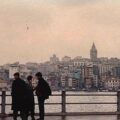Istanbul is a city that swaddles many cultures within it. Being on cultural crossroads for 3000 years, the city has a long tradition of extending warm hospitality to travelers landing on its shores. It also quickly becomes home for those who choose to linger a little longer.
While most visitors today gape at the mosaics of the Hagia Sophia, hunt for bargains at the Grand Bazaar, travel back in time at the Topkapi Palace or admire the views across the Bosphorus from the Galata Tower; very few venture beyond the tourist spots of Istanbul.
The city has layers, and if you do not go beyond the Sultanahmet District or the Taksim Square, it is nothing less than a crime!
When a friend and I decided to explore this city for a full week (yes one whole week!), we did not for once doubt running out of things to do. Just watching the city pass by, sitting at a café, was enough to make us fall in love with it.
But we were still amazed by how much the Istanbul offered once we veered off the beaten track.
One such adventure was a walk-through Fener and Balat, neighborhoods in the Fatih District. A less visited but one of the most historic and culturally diverse localities of this city.
UNESCO also authenticates the relevance of what it holds by enlisting this area as one of the heritage sites around the culturally vibrant city of Istanbul.
Historically, Fener and Balat were the Greek Orthodox and Jewish hearts of the city of Constantinople, respectively. Mostly occupied by traders, who made Istanbul their home at that time, these localities thrived for many years on commerce. Slowly, they became part of the fabric that gave Istanbul its exotic charm.
The population was a vibrant mix of Sephardic Jews from Spain, Greek and Armenian Christians.
Our local guide, who was a cheerful young lady, brought to life the history of these localities on our walk along the narrow labyrinth of steep winding roads.
The bus from Eminonu dropped us in the heart of Fener from where we headed to our first stop, the Ecumenical Orthodox Patriarchate which has been the spiritual center of the Greek Orthodox world since around 1600.
We reached just in time to witness our first Eastern Orthodox Church service. Even if you don’t get to experience a ceremony, just a look inside the Church with its colorful mosaics and eye-catching sculptures will make your visit an unforgettable affair.

A steep climb from here, through old delipidated but pretty houses, brought us to the Phanar Greek Orthodox College. With its imposing red brick building, it is a sight to behold. Pre-dating the Ottoman rule, it is one of the oldest educational institutions. Unfortunately, today only 50-odd students study here.
A fascinating addition would have been the Fethiye Museum which was a Byzantine church being converted into a museum. However, during our visit, it was under restoration.
Our next stop was the Chora (Kariye) Museum that boasts stunning mosaics depicting essential events in Christianity. Like many of the monuments in Istanbul, this one also reveals as much about the city and its chequered past as it does about itself.
Our walk also took us through a rejuvenated Balat neighborhood with its chic cafés and restaurants that have led an urban revolution of sorts. With its intriguing facades and quirky themes, they offer not only Insta-worthy photo-ops but also a pleasant break to taste some mouth-watering food.
Apart from an array of European restaurants, there are a few that give you an authentic taste of local dishes. We dug into meatballs and had a slice of Pide (Turkish Pizza) accompanied by a glass of Raki. Finally, we finished our short yet delicious lunch with lokum (aka Turkish Delight).

The final stop was the St. Stephens of the Bulgars Church located along the shores of the Golden Horn. Assembled in the late 1800s, it is built in a neo-Gothic style from pre-fabricated cast iron.
Parts of this architecturally beautiful building were made in Vienna and floated down the Danube to Istanbul. Still in use by the small Bulgarian Orthodox Christian community, the interiors of the Church boast of stunning glass mosaics.
Set along the Golden Horn, the gems we discovered through two of the oldest neighborhoods in Istanbul were worth every bit the steep climb through its cobbled streets. It was a walk back in time where children played on the streets lined with quaint houses, which in some cases were 200-years old.
A generation who has seen it all still survives in old crumbling structures with crisscross laundry lines, and the aura in the district is vintage to the core, as I notice older women in headscarves chatting in a corner.
The character of a city resides in pockets like these. So, the next time you visit Istanbul, spare a day for this vibrant and historic corner that takes you to the heart of this glorious city. A city that not only straddles two continents but boasts of a rich heritage that is over 2000 years old.
Photos: Author, Pixabay, and Unsplash



1 Comment
Passport Overused
Great post 🙂